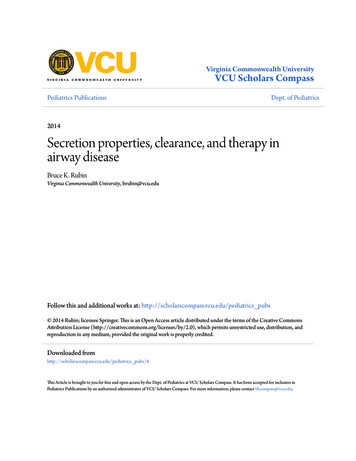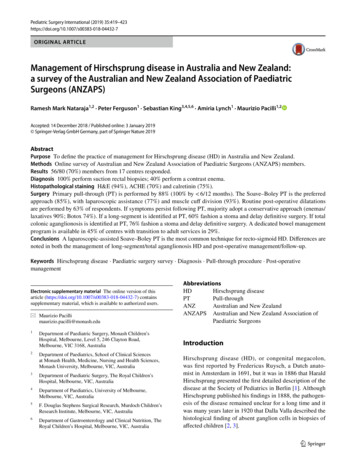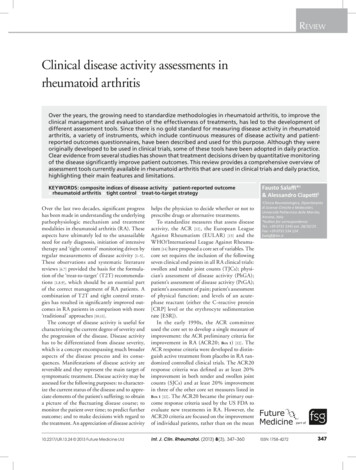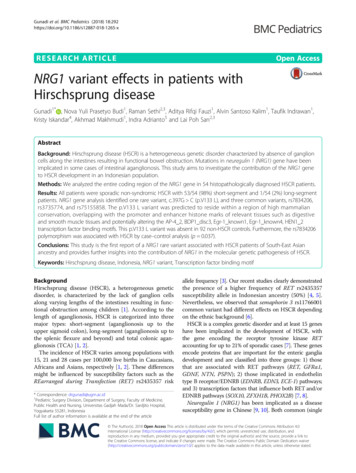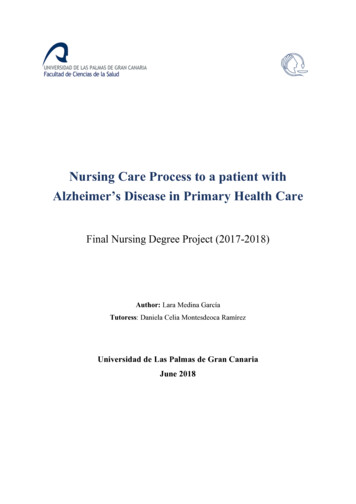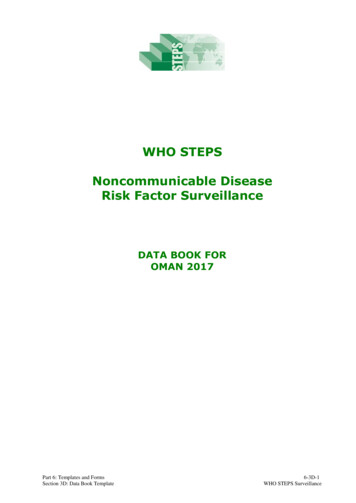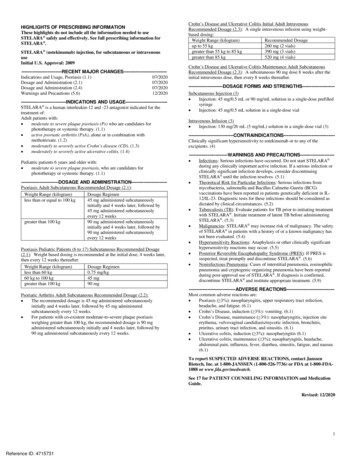
Transcription
HIGHLIGHTS OF PRESCRIBING INFORMATIONThese highlights do not include all the information needed to useSTELARA safely and effectively. See full prescribing information forSTELARA .STELARA (ustekinumab) injection, for subcutaneous or intravenoususeInitial U.S. Approval: 2009--------------------------RECENT MAJOR CHANGES--------------------------- Indications and Usage, Psoriasis (1.1)07/2020Dosage and Administration (2.1)07/2020Dosage and Administration (2.4)07/2020Warnings and Precautions NS AND USAGE-------------------------- STELARA is a human interleukin-12 and -23 antagonist indicated for thetreatment of:Adult patients with: moderate to severe plaque psoriasis (Ps) who are candidates forphototherapy or systemic therapy. (1.1) active psoriatic arthritis (PsA), alone or in combination withmethotrexate. (1.2) moderately to severely active Crohn’s disease (CD). (1.3) moderately to severely active ulcerative colitis. (1.4)Pediatric patients 6 years and older with: moderate to severe plaque psoriasis, who are candidates forphototherapy or systemic therapy. (1.1)------------------------DOSAGE AND ADMINISTRATION---------------------- Psoriasis Adult Subcutaneous Recommended Dosage (2.1):Weight Range (kilogram)Dosage Regimenless than or equal to 100 kg45 mg administered subcutaneouslyinitially and 4 weeks later, followed by45 mg administered subcutaneouslyevery 12 weeksgreater than 100 kg90 mg administered subcutaneouslyinitially and 4 weeks later, followed by90 mg administered subcutaneouslyevery 12 weeksPsoriasis Pediatric Patients (6 to 17) Subcutaneous Recommended Dosage(2.1): Weight based dosing is recommended at the initial dose, 4 weeks later,then every 12 weeks thereafter.Weight Range (kilogram)Dosage Regimenless than 60 kg0.75 mg/kg60 kg to 100 kg45 mggreater than 100 kg90 mgPsoriatic Arthritis Adult Subcutaneous Recommended Dosage (2.2): The recommended dosage is 45 mg administered subcutaneouslyinitially and 4 weeks later, followed by 45 mg administeredsubcutaneously every 12 weeks. For patients with co-existent moderate-to-severe plaque psoriasisweighing greater than 100 kg, the recommended dosage is 90 mgadministered subcutaneously initially and 4 weeks later, followed by90 mg administered subcutaneously every 12 weeks.Crohn’s Disease and Ulcerative Colitis Initial Adult IntravenousRecommended Dosage (2.3): A single intravenous infusion using weightbased dosing:Weight Range (kilogram)Recommended Dosageup to 55 kg260 mg (2 vials)greater than 55 kg to 85 kg390 mg (3 vials)greater than 85 kg520 mg (4 vials)Crohn’s Disease and Ulcerative Colitis Maintenance Adult SubcutaneousRecommended Dosage (2.3): A subcutaneous 90 mg dose 8 weeks after theinitial intravenous dose, then every 8 weeks thereafter.----------------------DOSAGE FORMS AND STRENGTHS-------------------- Subcutaneous Injection (3) Injection: 45 mg/0.5 mL or 90 mg/mL solution in a single-dose prefilledsyringe Injection: 45 mg/0.5 mL solution in a single-dose vialIntravenous Infusion (3) Injection: 130 mg/26 mL (5 mg/mL) solution in a single-dose vial ------------------------------- Clinically significant hypersensitivity to ustekinumab or to any of theexcipients. (4)-------------------------WARNINGS AND PRECAUTIONS--------------------- Infections: Serious infections have occurred. Do not start STELARA during any clinically important active infection. If a serious infection orclinically significant infection develops, consider discontinuingSTELARA until the infection resolves. (5.1) Theoretical Risk for Particular Infections: Serious infections frommycobacteria, salmonella and Bacillus Calmette-Guerin (BCG)vaccinations have been reported in patients genetically deficient in IL 12/IL-23. Diagnostic tests for these infections should be considered asdictated by clinical circumstances. (5.2) Tuberculosis (TB): Evaluate patients for TB prior to initiating treatmentwith STELARA . Initiate treatment of latent TB before administeringSTELARA . (5.3) Malignancies: STELARA may increase risk of malignancy. The safetyof STELARA in patients with a history of or a known malignancy hasnot been evaluated. (5.4) Hypersensitivity Reactions: Anaphylaxis or other clinically significanthypersensitivity reactions may occur. (5.5) Posterior Reversible Encephalopathy Syndrome (PRES): If PRES issuspected, treat promptly and discontinue STELARA . (5.6) Noninfectious Pneumonia: Cases of interstitial pneumonia, eosinophilicpneumonia and cryptogenic organizing pneumonia have been reportedduring post-approval use of STELARA . If diagnosis is confirmed,discontinue STELARA and institute appropriate treatment. (5.9)------------------------------ADVERSE REACTIONS------------------------------ Most common adverse reactions are: Psoriasis ( 3%): nasopharyngitis, upper respiratory tract infection,headache, and fatigue. (6.1) Crohn’s Disease, induction ( 3%): vomiting. (6.1) Crohn’s Disease, maintenance ( 3%): nasopharyngitis, injection siteerythema, vulvovaginal candidiasis/mycotic infection, bronchitis,pruritus, urinary tract infection, and sinusitis. (6.1) Ulcerative colitis, induction ( 3%): nasopharyngitis (6.1) Ulcerative colitis, maintenance ( 3%): nasopharyngitis, headache,abdominal pain, influenza, fever, diarrhea, sinusitis, fatigue, and nausea(6.1)To report SUSPECTED ADVERSE REACTIONS, contact JanssenBiotech, Inc. at 1-800-JANSSEN (1-800-526-7736) or FDA at 1-800-FDA 1088 or www.fda.gov/medwatch.See 17 for PATIENT COUNSELING INFORMATION and MedicationGuide.Revised: 12/20201Reference ID: 4715731
FULL PRESCRIBING INFORMATION: CONTENTS*123456INDICATIONS AND USAGEPsoriasis (Ps)Psoriatic Arthritis (PsA)Crohn’s Disease (CD)Ulcerative ColitisDOSAGE AND ADMINISTRATIONPsoriasisPsoriatic ArthritisCrohn’s Disease and Ulcerative ColitisGeneral Considerations for AdministrationInstructions for Administration of STELARA Prefilled Syringes Equipped with Needle SafetyGuardPreparation and Administration of STELARA 130 mg/26 mL (5 mg/mL) Vial for IntravenousInfusion (Crohn’s Disease and Ulcerative Colitis)DOSAGE FORMS AND STRENGTHSCONTRAINDICATIONSWARNINGS AND PRECAUTIONSInfectionsTheoretical Risk for Vulnerability to ParticularInfectionsPre-treatment Evaluation for TuberculosisMalignanciesHypersensitivity ReactionsPosterior Reversible Encephalopathy Syndrome(PRES)ImmunizationsConcomitant TherapiesNoninfectious PneumoniaADVERSE REACTIONSClinical Trials eting ExperienceDRUG INTERACTIONSConcomitant TherapiesCYP450 SubstratesAllergen ImmunotherapyUSE IN SPECIFIC POPULATIONSPregnancyLactationPediatric UseGeriatric UseOVERDOSAGEDESCRIPTIONCLINICAL PHARMACOLOGYMechanism of ActionPharmacodynamicsPharmacokineticsNONCLINICAL TOXICOLOGYCarcinogenesis, Mutagenesis, Impairment ofFertilityAnimal Toxicology and/or PharmacologyCLINICAL STUDIESPsoriasisAdolescent Subjects with Plaque PsoriasisPsoriatic ArthritisCrohn’s DiseaseUlcerative ColitisREFERENCESHOW SUPPLIED/STORAGE AND HANDLINGPATIENT COUNSELING INFORMATION*Sections or subsections omitted from the full prescribing information are notlisted.2Reference ID: 4715731
FULL PRESCRIBING INFORMATION1INDICATIONS AND USAGEPsoriasis (Ps)STELARA is indicated for the treatment of patients 6 years or older with moderate to severeplaque psoriasis who are candidates for phototherapy or systemic therapy.Psoriatic Arthritis (PsA)STELARA is indicated for the treatment of adult patients with active psoriatic arthritis.STELARA can be used alone or in combination with methotrexate (MTX).Crohn’s Disease (CD)STELARA is indicated for the treatment of adult patients with moderately to severely activeCrohn’s disease.Ulcerative ColitisSTELARA is indicated for the treatment of adult patients with moderately to severely activeulcerative colitis.2DOSAGE AND ADMINISTRATIONPsoriasisSubcutaneous Adult Dosage Regimen For patients weighing 100 kg or less, the recommended dose is 45 mg initially and 4 weekslater, followed by 45 mg every 12 weeks. For patients weighing more than 100 kg, the recommended dose is 90 mg initially and4 weeks later, followed by 90 mg every 12 weeks.In subjects weighing more than 100 kg, 45 mg was also shown to be efficacious. However, 90 mgresulted in greater efficacy in these subjects [see Clinical Studies (14)].Subcutaneous Pediatric Dosage RegimenAdminister STELARA subcutaneously at Weeks 0 and 4, then every 12 weeks thereafter.The recommended dose of STELARA for pediatric patients (6-17 years old) based on bodyweight is shown below (Table 1).3Reference ID: 4715731
Table 1:Recommended Dose of STELARA for Subcutaneous Injection in Pediatric Patients (6 17 years old) with PsoriasisBody Weight of Patient at the Time of Dosingless than 60 kg60 kg to 100 kgmore than 100 kgRecommended Dose0.75 mg/kg45 mg90 mgFor pediatric patients weighing less than 60 kg, the administration volume for the recommendeddose (0.75 mg/kg) is shown in Table 2; withdraw the appropriate volume from the single-dose vial.Table 2:Injection volumes of STELARA 45 mg/0.5 mL single-dose vials forpediatric patients (6-17 years old)with psoriasis weighing less than60 kgBody Weight (kg)at the time 363738394041424344454647484950Dose 3030.831.532.33333.834.535.33636.837.5Volume ofinjection erence ID: 4715731
0.420.430.440.450.460.460.470.480.49Psoriatic ArthritisSubcutaneous Adult Dosage Regimen The recommended dose is 45 mg initially and 4 weeks later, followed by 45 mg every12 weeks. For patients with co-existent moderate-to-severe plaque psoriasis weighing more than100 kg, the recommended dose is 90 mg initially and 4 weeks later, followed by 90 mgevery 12 weeks.Crohn’s Disease and Ulcerative ColitisIntravenous Induction Adult Dosage RegimenA single intravenous infusion dose of STELARA using the weight-based dosage regimenspecified in Table 3 [see Instructions for dilution of STELARA 130 mg vial for intravenousinfusion (2.6)].Table 3:Initial Intravenous Dosage of STELARA Body Weight of Patient at the time ofdosingDose55 kg or less260 mgmore than 55 kg to 85 kg390 mgmore than 85 kg520 mgNumber of 130 mg/26 mL(5 mg/mL) STELARA vials234Subcutaneous Maintenance Adult Dosage RegimenThe recommended maintenance dosage is a subcutaneous 90 mg dose administered 8 weeks afterthe initial intravenous dose, then every 8 weeks thereafter.General Considerations for Administration STELARA is intended for use under the guidance and supervision of a physician.STELARA should only be administered to patients who will be closely monitored andhave regular follow-up visits with a physician. The appropriate dose should be determinedby a healthcare provider using the patient’s current weight at the time of dosing. In pediatricpatients, it is recommended that STELARA be administered by a healthcare provider. Ifa physician determines that it is appropriate, a patient may self-inject or a caregiver mayinject STELARA after proper training in subcutaneous injection technique. Patients5Reference ID: 4715731
should be instructed to follow the directions provided in the Medication Guide [seeMedication Guide]. The needle cover on the prefilled syringe contains dry natural rubber (a derivative of latex).The needle cover should not be handled by persons sensitive to latex. It is recommended that each injection be administered at a different anatomic location (suchas upper arms, gluteal regions, thighs, or any quadrant of abdomen) than the previousinjection, and not into areas where the skin is tender, bruised, erythematous, or indurated.When using the single-dose vial, a 1 mL syringe with a 27 gauge, ½ inch needle isrecommended. Prior to administration, visually inspect STELARA for particulate matter anddiscoloration. STELARA is a colorless to light yellow solution and may contain a fewsmall translucent or white particles. Do not use STELARA if it is discolored or cloudy,or if other particulate matter is present. STELARA does not contain preservatives;therefore, discard any unused product remaining in the vial and/or syringe.Instructions for Administration of STELARA Prefilled Syringes Equippedwith Needle Safety GuardRefer to the diagram below for the provided instructions.To prevent premature activation of the needle safety guard, do not touch the NEEDLEGUARD ACTIVATION CLIPS at any time during use. Hold the BODY and remove the NEEDLE COVER. Do not hold the PLUNGER orPLUNGER HEAD while removing the NEEDLE COVER or the PLUNGER maymove. Do not use the prefilled syringe if it is dropped without the NEEDLE COVERin place. Inject STELARA subcutaneously as recommended [see Dosage and Administration (2.1,2.2, 2.3)].6Reference ID: 4715731
Inject all of the medication by pushing in the PLUNGER until the PLUNGER HEAD iscompletely between the needle guard wings. Injection of the entire prefilled syringecontents is necessary to activate the needle guard. After injection, maintain the pressure on the PLUNGER HEAD and remove the needlefrom the skin. Slowly take your thumb off the PLUNGER HEAD to allow the emptysyringe to move up until the entire needle is covered by the needle guard, as shown by theillustration below: Used syringes should be placed in a puncture-resistant container.Preparation and Administration of STELARA 130 mg/26 mL (5 mg/mL) Vialfor Intravenous Infusion (Crohn’s Disease and Ulcerative Colitis)STELARA solution for intravenous infusion must be diluted, prepared and infused by ahealthcare professional using aseptic technique.1.Calculate the dose and the number of STELARA vials needed based on patient weight(Table 3). Each 26 mL vial of STELARA contains 130 mg of ustekinumab.2.Withdraw, and then discard a volume of the 0.9% Sodium Chloride Injection, USP fromthe 250 mL infusion bag equal to the volume of STELARA to be added (discard 26 mLsodium chloride for each vial of STELARA needed, for 2 vials- discard 52 mL, for7Reference ID: 4715731
3 vials- discard 78 mL, 4 vials- discard 104 mL). Alternatively, a 250 mL infusion bagcontaining 0.45% Sodium Chloride Injection, USP may be used.3.Withdraw 26 mL of STELARA from each vial needed and add it to the 250 mL infusionbag. The final volume in the infusion bag should be 250 mL. Gently mix.4.Visually inspect the diluted solution before infusion. Do not use if visibly opaque particles,discoloration or foreign particles are observed.5.Infuse the diluted solution over a period of at least one hour. Once diluted, the infusionshould be completely administered within eight hours of the dilution in the infusion bag.6.Use only an infusion set with an in-line, sterile, non-pyrogenic, low protein-binding filter(pore size 0.2 micrometer).7.Do not infuse STELARA concomitantly in the same intravenous line with other agents.8.STELARA does not contain preservatives. Each vial is for single use only. Discard anyremaining solution. Dispose any unused medicinal product in accordance with localrequirements.StorageIf necessary, the diluted infusion solution may be kept at room temperature up to 25 C (77 F) forup to 7 hours. Storage time at room temperature begins once the diluted solution has been prepared.The infusion should be completed within 8 hours after the dilution in the infusion bag (cumulativetime after preparation including the storage and the infusion period). Do not freeze. Discard anyunused portion of the infusion solution.3DOSAGE FORMS AND STRENGTHSSTELARA (ustekinumab) is a colorless to light yellow solution and may contain a few smalltranslucent or white particles.Subcutaneous Injection Injection: 45 mg/0.5 mL or 90 mg/mL solution in a single-dose prefilled syringe Injection: 45 mg/0.5 mL solution in a single-dose vialIntravenous Infusion 4Injection: 130 mg/26 mL (5 mg/mL) solution in a single-dose vialCONTRAINDICATIONSSTELARA is contraindicated in patients with clinically significant hypersensitivity toustekinumab or to any of the excipients [see Warnings and Precautions (5.5)].8Reference ID: 4715731
5WARNINGS AND PRECAUTIONSInfectionsSTELARA may increase the risk of infections and reactivation of latent infections. Seriousbacterial, mycobacterial, fungal, and viral infections were observed in patients receivingSTELARA [see Adverse Reactions (6.1, 6.3)].Serious infections requiring hospitalization, or otherwise clinically significant infections, reportedin clinical studies included the following: Psoriasis: diverticulitis, cellulitis, pneumonia, appendicitis, cholecystitis, sepsis,osteomyelitis, viral infections, gastroenteritis and urinary tract infections. Psoriatic arthritis: cholecystitis. Crohn’s disease: anal abscess, gastroenteritis, ophthalmic herpes zoster, pneumonia, andlisteria meningitis. Ulcerative colitis: gastroenteritis, ophthalmic herpes zoster, pneumonia, and listeriosis.Treatment with STELARA should not be initiated in patients with any clinically important activeinfection until the infection resolves or is adequately treated. Consider the risks and benefits oftreatment prior to initiating use of STELARA in patients with a chronic infection or a history ofrecurrent infection.Instruct patients to seek medical advice if signs or symptoms suggestive of an infection occur whileon treatment with STELARA and consider discontinuing STELARA for serious or clinicallysignificant infections until the infection resolves or is adequately treated.Theoretical Risk for Vulnerability to Particular InfectionsIndividuals genetically deficient in IL-12/IL-23 are particularly vulnerable to disseminatedinfections from mycobacteria (including nontuberculous, environmental mycobacteria),salmonella (including nontyphi strains), and Bacillus Calmette-Guerin (BCG) vaccinations.Serious infections and fatal outcomes have been reported in such patients.It is not known whether patients with pharmacologic blockade of IL-12/IL-23 from treatment withSTELARA may be susceptible to these types of infections. Appropriate diagnostic testing shouldbe considered, e.g., tissue culture, stool culture, as dictated by clinical circumstances.Pre-treatment Evaluation for TuberculosisEvaluate patients for tuberculosis infection prior to initiating treatment with STELARA .Do not administer STELARA to patients with active tuberculosis infection. Initiate treatment oflatent tuberculosis prior to administering STELARA . Consider anti-tuberculosis therapy prior toinitiation of STELARA in patients with a past history of latent or active tuberculosis in whom anadequate course of treatment cannot be confirmed. Closely monitor patients receiving STELARA for signs and symptoms of active tuberculosis during and after treatment.9Reference ID: 4715731
MalignanciesSTELARA is an immunosuppressant and may increase the risk of malignancy. Malignancieswere reported among subjects who received STELARA in clinical studies [see Adverse Reactions(6.1)]. In rodent models, inhibition of IL-12/IL-23p40 increased the risk of malignancy [seeNonclinical Toxicology (13)].The safety of STELARA has not been evaluated in patients who have a history of malignancy orwho have a known malignancy.There have been post-marketing reports of the rapid appearance of multiple cutaneous squamouscell carcinomas in patients receiving STELARA who had pre-existing risk factors for developingnon-melanoma skin cancer. All patients receiving STELARA should be monitored for theappearance of non-melanoma skin cancer. Patients greater than 60 years of age, those with amedical history of prolonged immunosuppressant therapy and those with a history of PUVAtreatment should be followed c
STELARA safely and effectively. See full prescribing information for . should be instructed to follow the directions provided in the Medication Guide [see Medication Guide]. The needle cover on the prefilled syr
